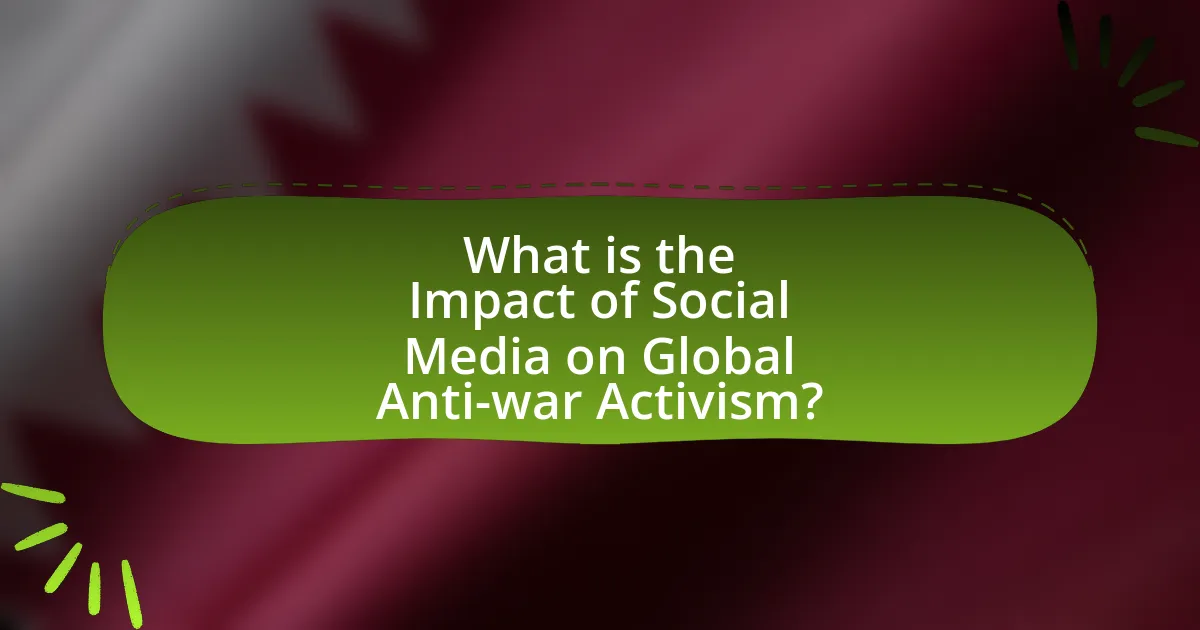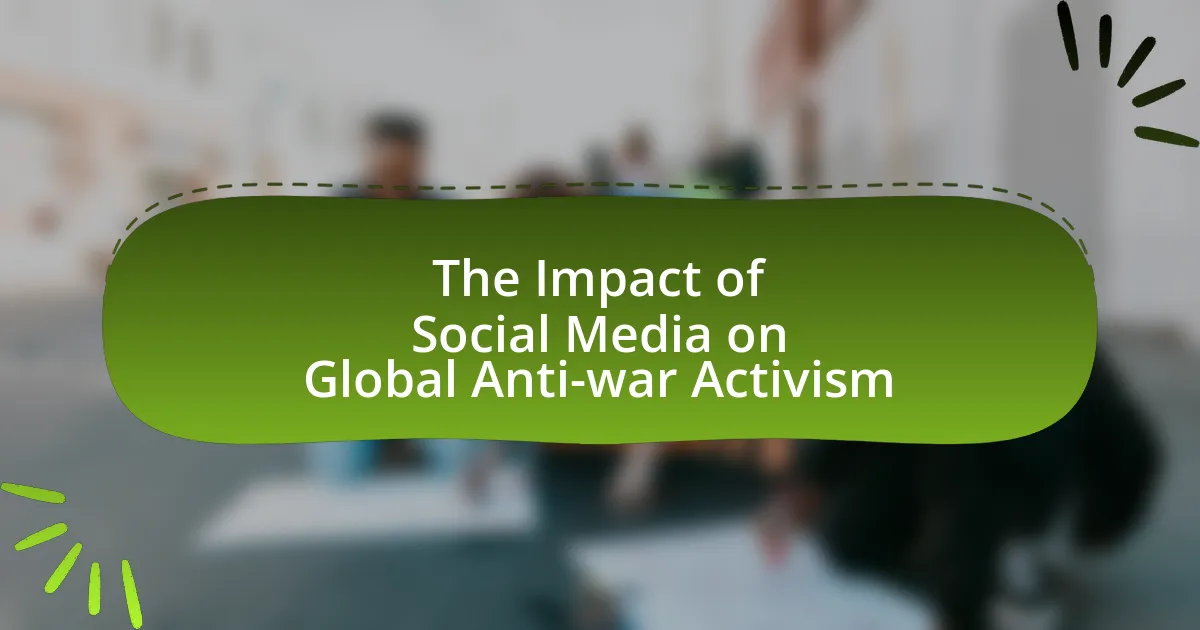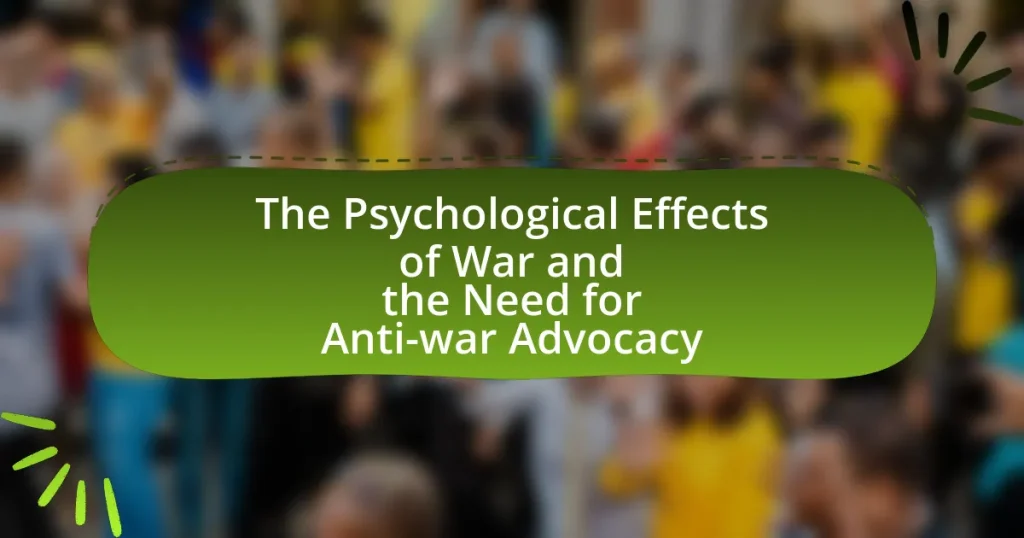The article examines the impact of social media on global anti-war activism, highlighting how platforms like Twitter and Facebook facilitate rapid information dissemination, mobilization, and community building among activists. It discusses the transformative role of social media in organizing protests, increasing public engagement, and amplifying marginalized voices, particularly during significant movements such as the Arab Spring and the #MeToo campaign. Additionally, the article addresses the challenges activists face, including censorship and misinformation, while outlining strategies for effective engagement and the potential future trends in social media activism.

What is the Impact of Social Media on Global Anti-war Activism?
Social media significantly enhances global anti-war activism by facilitating rapid information dissemination and mobilizing support across diverse populations. Platforms like Twitter and Facebook allow activists to share real-time updates, organize protests, and create awareness about conflicts, leading to increased public engagement. For instance, during the 2011 Arab Spring, social media played a crucial role in coordinating protests against authoritarian regimes, demonstrating its power in uniting individuals for a common cause. Additionally, studies indicate that social media campaigns can influence public opinion and policy decisions, as seen in the widespread opposition to military interventions in Syria and Iraq, where online movements garnered millions of supporters.
How has social media transformed the landscape of anti-war activism?
Social media has significantly transformed the landscape of anti-war activism by enabling rapid information dissemination and fostering global connectivity among activists. Platforms like Twitter and Facebook allow individuals and organizations to share real-time updates, mobilize protests, and raise awareness about conflicts, reaching a wider audience than traditional media. For instance, during the 2011 Arab Spring, social media played a crucial role in organizing protests against authoritarian regimes, demonstrating its power in facilitating grassroots movements. Additionally, studies show that social media campaigns can lead to increased public engagement and support for anti-war initiatives, as seen in the widespread online mobilization against the Iraq War in the early 2000s. This shift has made anti-war activism more accessible and impactful, allowing diverse voices to contribute to the discourse and challenge mainstream narratives.
What are the key features of social media that facilitate activism?
The key features of social media that facilitate activism include rapid information dissemination, community building, and mobilization capabilities. Rapid information dissemination allows activists to share news and updates instantly, reaching a global audience; for instance, during the Arab Spring, platforms like Twitter played a crucial role in spreading information about protests. Community building occurs through the formation of online groups and networks, enabling like-minded individuals to connect and collaborate; Facebook groups have been instrumental in organizing events and discussions around social causes. Mobilization capabilities are enhanced by features such as event creation and sharing, which enable users to organize and participate in protests or campaigns effectively; for example, the #MeToo movement utilized social media to mobilize millions worldwide, demonstrating the power of collective action facilitated by these platforms.
How do social media platforms enable global connectivity among activists?
Social media platforms enable global connectivity among activists by providing instant communication channels that transcend geographical boundaries. These platforms facilitate the sharing of information, mobilization of support, and coordination of actions among diverse activist groups worldwide. For instance, during the Arab Spring, activists utilized Twitter and Facebook to organize protests and disseminate real-time updates, leading to widespread international awareness and solidarity. Additionally, social media allows for the creation of global networks, where activists can collaborate on campaigns, share resources, and amplify their messages, as seen in movements like #MeToo and Black Lives Matter, which gained traction across multiple countries through online engagement.
Why is social media a crucial tool for anti-war movements?
Social media is a crucial tool for anti-war movements because it enables rapid dissemination of information and mobilization of supporters. Platforms like Twitter and Facebook allow activists to share real-time updates, organize protests, and amplify their messages to a global audience. For instance, during the 2011 Arab Spring, social media played a pivotal role in coordinating protests against oppressive regimes, demonstrating its effectiveness in fostering collective action. Additionally, studies show that social media can increase public awareness and engagement, as seen in the #NoWar movement, which gained significant traction online, influencing public opinion and policy discussions.
What advantages does social media provide over traditional activism methods?
Social media offers several advantages over traditional activism methods, primarily through its ability to reach a wider audience quickly and facilitate real-time communication. Unlike traditional methods, which often rely on physical gatherings or printed materials, social media platforms enable activists to disseminate information instantly to millions of users globally. For instance, during the Arab Spring, social media played a crucial role in mobilizing protests and sharing information, demonstrating its effectiveness in organizing large-scale movements rapidly. Additionally, social media allows for greater engagement and interaction, enabling activists to connect with supporters and share diverse perspectives, which traditional methods may not facilitate as effectively.
How does social media amplify the voices of marginalized groups in anti-war activism?
Social media amplifies the voices of marginalized groups in anti-war activism by providing a platform for direct communication and widespread dissemination of their messages. This digital space allows individuals and organizations from underrepresented communities to share their perspectives, experiences, and calls to action without the barriers typically imposed by traditional media outlets. For instance, during the 2017 Women’s March, social media facilitated the mobilization of diverse groups, showcasing the intersectionality of anti-war sentiments and highlighting the voices of women of color and other marginalized communities. Research indicates that social media campaigns can reach millions quickly, as seen in the #NoWarWithIran movement, which united various marginalized voices against military intervention, demonstrating the effectiveness of these platforms in fostering solidarity and raising awareness.
What challenges do activists face when using social media?
Activists face significant challenges when using social media, including censorship, misinformation, and algorithmic bias. Censorship can occur when platforms restrict or remove content that is deemed controversial or politically sensitive, limiting the reach of activist messages. Misinformation spreads rapidly on social media, making it difficult for activists to convey accurate information and mobilize support effectively. Additionally, algorithmic bias can prioritize certain narratives over others, often marginalizing the voices of activists advocating for anti-war causes. A study by the Pew Research Center found that 64% of Americans believe social media platforms have a negative impact on the way news is reported, highlighting the difficulties activists encounter in navigating these platforms.
How do misinformation and propaganda affect anti-war campaigns on social media?
Misinformation and propaganda significantly undermine anti-war campaigns on social media by distorting public perception and creating division among activists. These tactics can lead to the spread of false narratives that misrepresent the motives and actions of anti-war movements, thereby diminishing their credibility. For instance, during the Iraq War, misinformation campaigns portrayed anti-war activists as unpatriotic, which weakened public support for their cause. Additionally, studies have shown that social media algorithms often amplify sensationalist content, making it easier for misleading information to reach a wider audience, thus complicating the efforts of genuine anti-war advocates to convey accurate information and mobilize support.
What are the risks of surveillance and censorship for activists on social media?
Surveillance and censorship pose significant risks for activists on social media, primarily by compromising their safety and freedom of expression. Activists may face government monitoring, which can lead to harassment, arrest, or violence, as evidenced by reports from organizations like Amnesty International that document cases of activists being targeted for their online activities. Censorship can limit the reach of their messages, stifling important discourse and mobilization efforts, as seen in countries where social media platforms are restricted or heavily monitored. These risks create an environment of fear, discouraging participation in activism and undermining the effectiveness of social movements.
How do different demographics engage with social media for anti-war activism?
Different demographics engage with social media for anti-war activism through tailored content and platform preferences that resonate with their values and experiences. For instance, younger individuals, particularly Millennials and Gen Z, predominantly utilize platforms like Instagram and TikTok to share visually engaging content, such as memes and short videos, which can quickly spread awareness and mobilize support. In contrast, older demographics, such as Baby Boomers, may prefer Facebook and Twitter for sharing articles, organizing events, and participating in discussions, reflecting their inclination towards more traditional forms of communication.
Research indicates that 70% of young activists believe social media is crucial for raising awareness about social issues, including anti-war movements, while older generations often leverage these platforms to connect with like-minded individuals and share in-depth analyses (Pew Research Center, 2021). Additionally, marginalized communities often use social media to amplify their voices and experiences related to war, utilizing hashtags and campaigns that highlight their unique perspectives and challenges. This multifaceted engagement illustrates how different demographics adapt their social media strategies to effectively advocate for anti-war activism.
What role do youth play in shaping anti-war narratives on social media?
Youth play a crucial role in shaping anti-war narratives on social media by leveraging their digital fluency to mobilize support and disseminate information. They utilize platforms like Twitter, Instagram, and TikTok to share personal stories, create impactful visuals, and engage in discussions that challenge pro-war sentiments. For instance, during the 2022 Russia-Ukraine conflict, youth-led movements utilized hashtags and viral challenges to raise awareness and promote peace, demonstrating their ability to influence public opinion. Research indicates that social media campaigns initiated by young activists can significantly increase engagement and awareness, as seen in the #NeverAgain movement following school shootings in the U.S., which also addressed broader issues of violence and war.
How do cultural differences influence the use of social media in anti-war movements?
Cultural differences significantly influence the use of social media in anti-war movements by shaping communication styles, messaging strategies, and audience engagement. For instance, in collectivist cultures, social media campaigns often emphasize community solidarity and shared values, leading to collective action, while in individualistic cultures, campaigns may focus on personal narratives and individual rights, which can drive different forms of engagement. Research indicates that cultural context affects the choice of platforms; for example, in regions where Facebook is dominant, anti-war movements may utilize it for organizing and mobilizing, whereas in areas where Twitter is more prevalent, concise messaging and rapid dissemination of information become key. Additionally, cultural norms dictate the appropriateness of certain content, influencing how messages are framed and received, which can either enhance or hinder the effectiveness of anti-war campaigns.
What strategies can enhance the effectiveness of social media in anti-war activism?
Utilizing targeted messaging and engaging visuals can significantly enhance the effectiveness of social media in anti-war activism. Targeted messaging ensures that the content resonates with specific audiences, increasing the likelihood of engagement and sharing. For instance, campaigns that address local impacts of war or highlight personal stories can create emotional connections, driving more people to participate. Engaging visuals, such as infographics and videos, can convey complex information quickly and effectively, making it easier for users to understand the issues at hand. Research indicates that posts with images receive 94% more views than those without, underscoring the importance of visual content in capturing attention. Additionally, leveraging hashtags and trends can amplify reach, as seen in movements like #NoWar and #PeaceNow, which have successfully mobilized global audiences.
How can activists leverage storytelling to engage audiences on social media?
Activists can leverage storytelling to engage audiences on social media by creating relatable narratives that resonate emotionally with their followers. This approach allows activists to humanize complex issues, making them more accessible and compelling. For instance, sharing personal experiences or testimonials related to anti-war sentiments can evoke empathy and drive engagement, as evidenced by campaigns like the “Humans of New York” series, which effectively uses storytelling to highlight individual struggles and foster community support. By utilizing visuals, such as images and videos, alongside these narratives, activists can enhance the emotional impact and shareability of their messages, leading to increased awareness and mobilization around anti-war causes.
What best practices should activists follow to maximize their impact on social media?
Activists should focus on creating engaging, authentic content to maximize their impact on social media. Engaging content encourages interaction, which can increase visibility and reach. Authenticity builds trust with the audience, making them more likely to share and support the cause. Research indicates that posts with personal stories or emotional appeals generate higher engagement rates, with a study by the Pew Research Center showing that 69% of social media users are more likely to support causes that resonate personally. Additionally, activists should utilize hashtags strategically to increase discoverability and join broader conversations, as hashtags can boost post visibility by up to 12.6%. Regularly interacting with followers through comments and messages fosters community and encourages ongoing support.
What future trends can we expect in social media and anti-war activism?
Future trends in social media and anti-war activism will likely include increased use of decentralized platforms and enhanced multimedia storytelling. As traditional social media faces scrutiny over censorship and data privacy, activists may shift towards decentralized networks like Mastodon or blockchain-based platforms, which offer greater control and security. Additionally, the integration of augmented reality (AR) and virtual reality (VR) in campaigns will allow for immersive experiences that can evoke stronger emotional responses and engagement from audiences. For instance, the use of VR in protests has already shown potential to create impactful narratives that resonate with viewers. These trends reflect a growing need for innovative approaches to mobilize support and raise awareness in an increasingly digital landscape.
How might emerging technologies influence the way activists use social media?
Emerging technologies significantly influence the way activists use social media by enhancing communication, data analysis, and outreach capabilities. For instance, advancements in artificial intelligence enable activists to analyze large datasets to identify trends and sentiments, allowing for more targeted messaging. Additionally, the rise of decentralized platforms and blockchain technology offers activists greater security and privacy, reducing the risk of censorship and surveillance. According to a 2021 study by the Pew Research Center, 69% of social media users believe these platforms are essential for political activism, highlighting their growing importance in mobilizing support and disseminating information effectively.
What potential shifts in public perception could arise from social media campaigns?
Social media campaigns can significantly shift public perception by increasing awareness and mobilizing support for anti-war movements. These campaigns often highlight personal stories, statistics, and visual content that resonate emotionally with audiences, leading to greater empathy and understanding of the issues at hand. For instance, the viral spread of images and testimonials during conflicts can humanize affected populations, prompting public outcry and calls for action. Research indicates that social media can amplify marginalized voices, making it easier for grassroots movements to gain traction and influence mainstream narratives. A study by the Pew Research Center found that 69% of adults in the U.S. believe social media is an effective tool for raising awareness about social issues, demonstrating its potential to reshape public attitudes and drive collective action against war.
What practical tips can activists use to navigate social media effectively?
Activists can navigate social media effectively by employing targeted strategies such as creating clear messaging, engaging with followers, and utilizing analytics tools. Clear messaging ensures that the core message of the activism is easily understood and shared, which is crucial for mobilizing support. Engaging with followers through comments and direct messages fosters community and encourages participation, enhancing the reach and impact of the activism. Utilizing analytics tools allows activists to track engagement metrics, helping them understand what content resonates most with their audience and adjust their strategies accordingly. These practices are supported by studies showing that effective communication and community engagement significantly increase the likelihood of successful activism on social media platforms.



